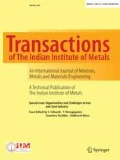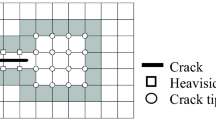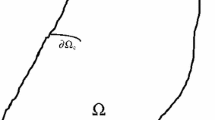Abstract
Multiple cracks/voids have been extensively seen in structural components. The stress field gets affected due to the crack interaction, so the effect of multiple cracks should be considered in design analysis. Further, due to service load, the stress concentrations are induced at the crack tips, which is the source of failure of the component. Hence, the current work has been proposed to investigate the crack interaction phenomenon in structural components under mechanical loading conditions. A mesh-independent computational approach, namely “Extended Finite Element Method (XFEM),” has been implemented for crack discontinuities modeling. Ramberg–Osgood material model has been used for the nonlinear stress–strain relationship of material. Isotropic hardening has been used with von Mises yield criteria to decide the plasticity condition. Further, nonlinear discrete equations have been solved by the Newton–Raphson iterative scheme. Few crack interaction problems are numerically solved by the presented EPFM approach, and results are presented in the form of fracture parameters.


















Similar content being viewed by others
References
Bolivar J, Frégonèse M, Réthoré J, Duret-Thual C, Combrade P, Evaluation of multiple stress corrosion crack interactions by in situ Digital Image Correlation, Corros. Sci. 128 (2017).
Mahmoud H, Chulahwat A,Riveros G, Fatigue and fracture life-cycle cost assessment of a Miter gate with multiple cracks, Eng. Fail. Anal. 83 (2018).
Pitt S, Jones R, Multiple-site and widespread fatigue damage in aging aircraft, Eng. Fail. Anal. 4 (1997).
Viola E, Non-singular stresses effects on two interacting equal collinear cracks, Eng. Fract. Mech. 18 (1983).
Dhondt G, Chergui A, Buchholz F G, Computational fracture analysis of different specimens regarding 3D and mode coupling effects, Eng. Fract. Mech. 68 (2001).
Rhee H C, Stress intensity factor evaluation from displacements along arbitrary crack tip radial lines for warped surface flaws, Eng. Fract. Mech. 32 (1989).
Moës N, Gravouil A, Belytschko T, Non-planar 3D crack growth by the extended finite element and level sets-Part I: Mechanical model, Int. J. Numer. Methods Eng. 53 (2002).
Pathak H, Singh A, Singh I V, Fatigue crack growth simulations of bi-material interfacial cracks under thermo-elastic loading by extended finite element method, Eur. J. Comput. Mech. 22 (2013) 79–104.
Pathak H, Mishra R K, Singh A, Singh I V, Simulation of 3-D Cracks under Thermo-Mechanical Environment, Materials Today: Proceedings 4 (2017).
R. Mishra, G. Burela, H. Pathak, Crack interaction study in piezoelectric materials under thermo-electro-mechanical loading environment, Int J Mech Mater Des. 15 (2018).
Reddy J N, An Introduction to Nonlinear Finite Element Analysis, second ed., Oxford University Press, New York, 2009.
Kumar S, Shedbale A S, Singh I V, Mishra B K, Elasto-plastic fatigue crack growth analysis of plane problems in the presence of flaws using XFEM, Front. Struct. Civ. Eng. 50 (2015).
American Society for Metals (ASM) Aerospace Specification Metals Incl., Aluminum alloy 6061-T6, http://asm.matweb.com/search/SpecificMaterial.asp?bassnum=MA6061t6 Explored on 25 March 2020
Mišović M, Tadić N, Lučić D, Deformation characteristics of aluminium alloys, GRAĐEVINAR 68 (2016).
Yan J-H, Sutton MA, Deng X, Wei Z, Zavattieri P, Mixed-mode crack growth in ductile thin-sheet materials under combined in-plane and out-of-plane loading, Int. J. Fract. 160 (2019).
D. Peng, R. Jones, The analysis of stress intensity factors in two interacting collinear asymmetric cracks in a finite plate, Theor. Appl. Fract. Mech. 75 (2015).
Author information
Authors and Affiliations
Corresponding author
Additional information
Publisher's Note
Springer Nature remains neutral with regard to jurisdictional claims in published maps and institutional affiliations.
Rights and permissions
About this article
Cite this article
Gajjar, M., Pathak, H. & Kumar, S. Elasto-Plastic Fracture Modeling for Crack Interaction with XFEM. Trans Indian Inst Met 73, 1679–1687 (2020). https://doi.org/10.1007/s12666-020-01972-2
Received:
Accepted:
Published:
Issue Date:
DOI: https://doi.org/10.1007/s12666-020-01972-2




